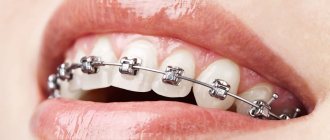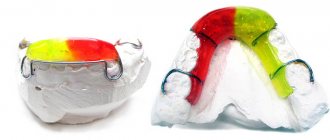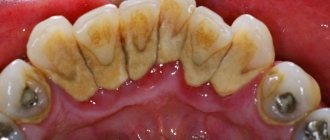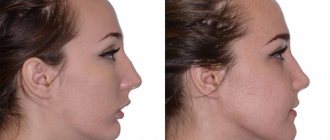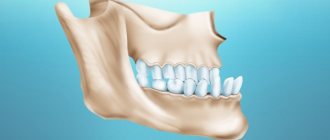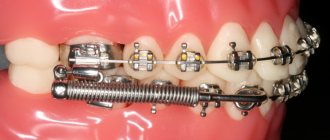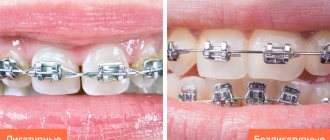Braces are special plates that are attached to the teeth to correct the bite. The plates are connected to each other by an arc, which, due to its elasticity, tends to take the correct position, puts pressure on the braces, and they, in turn, distribute the pressure on the teeth. Due to constant pressure, the bone tissue behind the tooth gradually decreases, the tooth moves to a new place and is fixed there. As a result, the bite becomes correct.
Most often, braces are installed in childhood, at 12–13 years old, when the jaw is still actively growing and more susceptible to changes. However, this does not mean that bite correction is only possible at this age - braces can also be installed on an adult. True, the treatment process in this case will have several features.
Indications for installing braces
As in childhood, in adulthood the only indication for installing braces is malocclusion. This anomaly is characterized by the following symptoms:
- Noticeable crowding of teeth, their creeping onto each other.
- Gaps between teeth.
- Teeth tilted back or forward.
- Excessive protrusion of one of the jaws forward or backward.
- Large distance between the teeth of the upper and lower jaw.
- Shift of the jaws or dentition laterally relative to each other.
These problems can be either noticeable even to the naked eye or hidden. Sometimes, at first glance, it seems to a person that everything is fine with his bite, although in fact there is a violation. In this case, only a dentist can recognize them during a professional examination.
Mesial bite: how long does it take to correct?
With such an anomaly in the closure of the teeth, the lower jaw protrudes forward, and the teeth of the lower row overlap the teeth of the upper one. Mesial occlusion significantly affects facial aesthetics. If the incisors of the two jaws do not meet, this can lead to problems with diction, speech and chewing.
It is impossible to slow down the growth of the lower jaw using dental methods. Therefore, with such a violation, the orthodontist most often decides to stimulate the growth and expansion of the upper jaw. To do this, braces are placed on the first molars and permanent incisors.
How long they are worn depends on various factors. For some, bite correction occurs after 1 year, for another patient it takes 2 years.
Why do you need to get braces?
Braces for an adult
Typically, braces are installed to improve your appearance. But sometimes malocclusions are almost invisible, so patients do not seek to correct them. But in fact, even a slight malocclusion can lead to serious consequences:
- Caries, gingivitis and other problems with teeth and gums due to uneven distribution of chewing load and injury to soft tissues from improperly growing teeth.
- Pain in the head and jaw due to improper positioning of teeth, compression of joints and nerves.
- Insufficient hygiene due to the fact that certain areas of the teeth cannot be approached due to other dental units.
- Rapid wear of individual teeth, abrasion and even loss.
- Digestive problems due to insufficient chewing of food.
- Inconvenience when using prosthetics in the future.
Therefore, even if there is no desire to make a smile beautiful, or if the bite does not spoil the appearance too much, treatment with braces is still necessary, since it is beneficial for health in the long term.
Literature
- Kopeikin V.N. Dental technology. –M.: Triada-X, 2003. -416s;
- Materials and technologies in orthopedic dentistry: a textbook for medical universities / Abdurakhmanov A.I. and others - - 2nd ed. - M.: Medicine, 2008.
- Orthopedic dentistry. / A.I. Abdurakhmanov, O.R. Kurbanov. - 3rd ed., - M.: 2021.
- Orthopedic dentistry. / V.N. Trezubov et al. - M., 2008. - 416 p.
- Poyurovskaya I. Ya. Dental materials science. – M., 2007. – 192 p.
- Propaedeutics of dental diseases: / Skorikova L.A. and others - Rostov n/d, 2002. -640 p.
Features of bite correction in adults
The rumor that only children can have braces did not appear out of nowhere. Indeed, by about 16–18 years, a person’s jaw stops actively growing, and his bones lose pliability. And if in childhood only a little pressure is enough to correct the bite, in adulthood everything is much more complicated:
- Correcting even minor defects requires at least a year, and sometimes treatment extends for 2–3 years.
- If there is no room for teeth, the jaw cannot be expanded; some teeth will have to be removed to create space for the rest.
- If the jaw is missing teeth or has dentures, this may complicate treatment and require the installation of special structures.
- After treatment, the teeth will tend to return to their original places, so it will take a long time to consolidate the results of the correction.
All this complicates the process, but does not mean that it is completely impossible to correct the bite in adulthood. Adults can wear braces, and although the treatment will be longer and more complex, it will still produce results and remain completely effective.
Indications and contraindications for correction of occlusion defects
Treatment of bite defects is performed exclusively for medical reasons:
- anomalies in the development of the dental system;
- curvature of one or more elements of the dentition;
- spaces between teeth;
- jaw bone injuries.
Contraindications to correctional therapy are divided into relative and absolute. Relative ones include those, having eliminated the cause of which, you can begin treatment. For example, the presence of carious teeth or an acute infectious disease.
Absolute contraindications:
- serious problems with the heart and blood vessels (in the stage of decompensation);
- mental disorders (schizophrenia, psychosis, etc.);
- pathologies of the immune system;
- bone diseases;
- endocrine diseases;
- blood diseases;
- oncology;
- AIDS;
- tuberculosis.
Relative restrictions:
- bruxism;
- dysfunction of the temporal mandibular joint;
- dental problems;
- allergy to the materials from which orthodontic structures are made;
- implants in the oral cavity.
Correction of dental anomalies begins only after collecting an anamnesis. Thus, the orthodontist identifies the presence of contraindications during a consultation. Our dental specialists take a very responsible approach to the problems of their patients.
Metal braces
Metal braces
The most common type of braces is metal. Both the braces themselves and the arch are made of a special medical alloy, safe and hypoallergenic. The composition of the alloy may vary depending on the brand of braces.
Modern metal braces are noticeably different from those that were common in Soviet times. They are not so huge and ugly, quite compact, less damaging to soft tissues and look good in the mouth. Many public figures and even stars are not shy about appearing in public with such braces.
Advantages
- Lower cost compared to other braces models.
- Wide range of models - manufacturers offer braces of different designs, depending on malocclusions and the wishes of the client.
- High strength - braces are much less likely to break and can cope with even serious malocclusions.
- Easier maintenance - you will still need a special brush for cleaning, but other systems take much longer to maintain.
- Easy to install - metal braces can be installed in almost any clinic, even in state dentistry under the insurance policy.
Flaws
- They are significantly inferior to other designs in terms of aesthetics and are much more noticeable on the teeth.
- While wearing it, a metallic taste is felt and the taste of food is distorted.
- Even modern metal braces cause allergies in some people.
- Metal braces still slightly injure the tongue, gums and cheeks; they often have to be sealed with special wax.
How long to wear braces for deep bites?
A deep bite is a type of abnormal bite in which the upper teeth overlap the lower teeth by more than a third. This disrupts chewing function, contributes to damage to tooth enamel, and can lead to soft tissue trauma. Different treatment methods are suitable for correcting deep bites, depending on the age of the patient and the severity of the disorder.
Children from 6 to 11 years old are most often given plates that correctly guide the growing jaw. In most cases, braces are used to correct deep bites in adolescents and adults. Braces are worn for deep bites for an average of one and a half years.
In difficult cases, orthodontic treatment is not enough and the patient may require surgery.
Ceramic braces
Ceramic braces
For adults, aesthetics is usually more important than for children - they need to appear in public more often and make a good impression. Therefore, ceramic braces are very popular among adults. Their arch is also made of metal, but the clasps are made of special medical ceramics.
Ceramics has a color that is as close as possible to tooth enamel. Thanks to this, braces are much less noticeable on the teeth. The metal arch is still noticeable, but it can be covered with white paint - then if people do not specifically look into your mouth, they will not even notice the braces.
Advantages
- Very high aesthetics.
- Greater hypoallergenicity - ceramics are a more biocompatible material, so they rarely provoke allergies.
- No unpleasant metallic taste in the mouth.
- Less trauma to soft tissues.
Flaws
- Slightly more brittle, which increases the risk of breakage, and also makes it difficult for braces to cope with some serious malocclusions.
- A little more complex care to ensure complete cleaning and maintain aesthetics.
- Some visibility - upon careful inspection, the braces are still visible.
- Difficult to install - such braces are unlikely to be installed in municipal dentistry, and they are not always found in private clinics.
In addition, ceramic braces are slightly more expensive than metal braces, although they are cheaper than many other types of braces. So this is a small drawback, but only relative to metal braces.
In general, if you are looking for a compromise between aesthetics and price, then ceramic braces are the best option.
Preparing to align rows with braces
Before installing braces, the doctor makes sure that the gums and teeth are in satisfactory condition.
If there is caries, pulpitis, gingivitis or any other dental disease, it must be treated. After installing metal arches, it is much more difficult to combat the symptoms of oral diseases. Also during the preparatory stage:
- radiography;
- taking impressions of both jaws;
- articulator examination.
Considering that each clinical case is unique, the patient may be prescribed consultations with a surgeon, orthopedist, or implantologist.
Sapphire braces
Sapphire braces
Another type of aesthetic braces is sapphire. They are made from a special artificially grown sapphire that is transparent, crystalline and sparkling. Its properties are close to natural sapphire, it is highly durable and does not cause allergies at all.
Sapphire braces are similar to ceramic braces in many ways, but they have a significant difference. In certain lighting, they are much more visible on the teeth, as the light is reflected in the edges of the artificial crystals. At the same time, such visibility looks beautiful, turning braces from an ordinary device for correcting the bite into an elegant decoration.
There is no point in considering their advantages and disadvantages separately - they are almost completely identical to ceramic ones, except that they cost a little more, but at the same time they look more prestigious. In addition, not every clinic has the opportunity to install sapphire braces - metal and ceramic are much more common.
Combined braces
Combined braces
When smiling, only the front teeth are visible, and only the upper ones are most noticeable. Therefore, it is not always necessary to place ceramic or sapphire structures on all teeth. To save money, you can install combined braces: put metal on some teeth, and ceramic or sapphire on others. Most often, for the greatest savings, aesthetic braces are placed only on the upper front teeth, although, if desired, you can also install ceramics or sapphire on the lower jaw.
Advantages
- Higher aesthetics compared to all-metal braces.
- Lower cost compared to sapphire or ceramic braces.
- Greater efficiency and versatility than ceramic braces.
- Greater strength - usually high loads fall on the chewing teeth, and the metal braces installed here cope better with them.
Flaws
- Slightly less aesthetics than braces made entirely of ceramic or sapphire - sometimes the structures are still visible when smiling or talking.
- Higher cost compared to metal braces.
- Low effectiveness for severe malocclusions, especially in the smile area.
- Difficult to install - only a highly qualified dentist can correctly install the combined system.
Open bite: how long should you wear braces?
With an open bite, a noticeable gap forms between the teeth. As a rule, it is located in the area of the front teeth and greatly affects the aesthetics of the smile. In addition, with an open bite, the patient may have a lisp, the tongue may fall out of the gap, which reduces the quality of life and affects self-esteem.
It is very difficult to treat open bites on permanent teeth, so the best option is to see an orthodontist in childhood. There are two main methods of treatment - with braces and with surgery. Sometimes doctors combine both methods: first, they correct the position of the teeth using a braces system, and then perform surgery on the jaws. The recommended period for wearing braces to correct an open bite is 2 years or longer.
Lingual braces
Lingual braces
All of the above braces are installed as standard on the front surface of the teeth. Because of this, even aesthetic braces are still noticeable under certain lighting and close inspection. These braces are called vestibular braces.
But there are also lingual braces. They are made of metal, but are attached not to the front, but to the back surface of the teeth, on the side of the tongue. Initially, they were designed for a specific purpose - thanks to the pressure from the inside, such braces did a good job of pushing the jaw forward. But then they began to be used for various malocclusions, since in terms of aesthetics, lingual braces are superior to all other types.
Advantages
- Complete aesthetics - braces are completely invisible on the teeth.
- Highly effective for certain malocclusions.
- Durability like metal braces.
Flaws
- The highest cost - they are even more expensive than sapphire braces.
- More complex care: Cleaning braces on the back of your teeth is not easy.
- Complex and lengthy installation - only a very experienced dentist can carry it out, and the process itself takes more time.
- Ineffective for certain malocclusions - Sometimes lingual braces are simply not able to correct the malocclusion.
- Sometimes the tongue is injured and diction is impaired.
Lingual braces can also be used in combination with regular ones, for example, put them on the upper jaw, and classic ones on the lower jaw.
Types and features of bracket systems
In the past, there were only metal braces - they were not aesthetically pleasing and caused some inconvenience. Today, a huge number of other devices are used for constant wear, and braces have become much more comfortable and aesthetically pleasing.
There are three classifications of systems, which are based on the installation method, mounting location, and material.
Types of braces according to the method of arch attachment
For adult patients, two types of stationary systems are used: ligature and self-ligating (ligature-free). To better understand how they differ from each other, you need to have a good understanding of the design of braces.
Braces consist of an arch and clasps that are located on the teeth. In ligature systems, the clasps are attached to the arch using special rings - ligatures. In self-ligating rings, such rings are not used - the arcs are inserted into a special groove.
Ligature braces
Ligature bracket systems have a classic design and have proven their effectiveness in various pathologies. They will ensure the correction of the bite in the shortest possible time, if we are talking about a relatively strong displacement of the teeth.
Such systems also have a drawback: the patient will have to come to the orthodontist every month for correction.
Self-ligating systems
Ligature-free braces have two key advantages: they are much more aesthetically pleasing and save the patient’s time. You will have to visit the orthodontist every one and a half to two months, and not monthly, as is the case with ligatures.
There is another advantage: such braces provide gentle but constant pressure on the teeth.
Types of braces according to installation site
Classic braces have always been installed on the outside of the teeth. However, in recent years, systems have appeared that can also be worn from the inside. Let's take a closer look at each type.
Vestibular (external) bracket systems
This is a classic version of the system: such braces are located on the outside of the dentition and are visible from the outside. Despite some damage to aesthetics, they are chosen most often due to their high efficiency and relatively low cost.
Lingual systems
Lingual or internal braces are much more aesthetically pleasing. They are simply not visible from the outside: all elements of the system are located on the back side of the dentition.
Lingual systems are more expensive and require some getting used to: they affect diction. However, if you work with people all the time, have a slight malocclusion, and don't want others to see your braces, you can use this option.
Types of braces by material
Once upon a time, only metal braces were available, and many who wanted to correct their bite were embarrassed to go to the orthodontist and wear braces for several years. The situation has changed: now the range of braces has expanded, and they began to be made from different materials - from traditional metal to ceramics and even sapphires. The appearance of the systems has also changed - now they look much more aesthetically pleasing and even look like decoration.
Metal bracket systems
These are inexpensive, fairly effective and reliable systems that have gained maximum popularity. Most often, such braces are made of medical steel - it does not cause irritation or allergies, and does not react with saliva and acids that may be in the oral cavity.
In addition to steel systems, titanium systems are used - the most durable and eliminate any reaction in the oral cavity, as well as gold. Gold braces are aesthetically pleasing and effective.
Plastic braces
This is the first type of system to appear as an alternative to metal braces. Plastic systems are aesthetic, almost invisible on the teeth, and are inexpensive. They also have disadvantages: low strength and the possibility of coloring. The first can be eliminated only by completely changing braces, the second can be eliminated by choosing colored systems.
Ceramic braces
Ceramic onlays on the teeth are difficult to notice and provide a good hold. However, like plastic ones, they can collapse under mechanical stress. Coloring is also possible - after strong tea, coffee, cherry juice, red wine.
Sapphire braces
Such systems are made from aluminum oxide. They are almost invisible on the teeth, and in terms of strength they are comparable to ceramic braces. Unfortunately, they also have a drawback - high cost.
Combined bracket systems
Doctors often choose combined braces. They combine the aesthetic appearance of ceramic structures (on the visible upper jaw row) and the strength of metal ones. Also, such designs are relevant if you need to create different tension on the teeth.
Plus this is due to:
- reasonable price for the patient;
- effective and short-term treatment;
- ability to correct complex cases.
Which braces to choose
As you can see, there are a lot of braces. True, you will need to choose between them not on your own, but together with the doctor, since the choice depends not only on the wishes of the patient, but also on the condition of the dental system. For example, quite often a patient would like to have aesthetic braces, but only metal braces can cope with his anomaly.
If you have a choice, then it is best to put:
- Metal braces, if there are no special requirements for aesthetics and there is a desire to save money.
- Ceramic, if you want not to spend too much on treatment, but at the same time maintain aesthetics.
- Sapphire, if there is a desire on the contrary, draw attention to your teeth and decorate them with “jewels”.
- Combined braces, if you are willing to sacrifice a little aesthetics for the sake of saving.
- Lingual, if you need maximum aesthetics.
Judging by the reviews, metal braces are still the most popular among adults, and many people are now calmly undergoing treatment with such structures, without facing the condemnation of others. Of the aesthetic designs, ceramic braces are the most popular, as they are quite inconspicuous, but not too expensive.
How to install braces for adults
The installation of braces follows the same scheme, regardless of the chosen system. It all starts with preparation, which takes place in several stages:
- The dentist talks with the patient, examines his teeth, and listens to his expectations from treatment.
- X-rays, computed tomography are done, and if necessary, an impression is taken. Based on this, the treatment is simulated on a computer.
- A decision is made on the material of braces based on the examination and the wishes of the patient.
- Sanitation of the oral cavity is carried out - all diseases of the gums and teeth are treated, so that in the future there will be no need to carry out treatment and remove braces for this. Professional cleaning is also required.
- If it is necessary to create free space in the jaw, individual teeth are removed - usually chewing molars.
After the teeth are completely prepared, the braces are installed directly. It goes according to the following scheme:
- The teeth are thoroughly cleaned of plaque and dried of saliva.
- The enamel is etched with a special acid. It is safe, but makes the enamel more susceptible to the adhesive.
- A small amount of adhesive glue is applied to the enamel. Some modern braces have an adhesive on the clasps themselves - in this case this step is skipped.
- Braces are attached to the teeth one at a time.
- Excess adhesive is removed so as not to create voids under the braces, and then hardens under the influence of a special lamp.
- An archwire is threaded into the braces.
At this point, the installation is considered complete, the patient is taught how to care for braces, the next follow-up appointment is scheduled, and he is sent home. The whole process takes about half an hour; in the case of lingual braces, it can take an hour.
After installation, the patient will need to visit the doctor several more times to monitor the correction of the bite and replace the arch with a less flexible one.
Other factors that affect the length of time you wear braces
The type of bite and the severity of the orthodontic defect are not the only factors that determine how long to wear braces. The following points also affect the timing:
- type of orthodontic structure;
- patient's age;
- individual characteristics of the body of a particular patient;
- quality of hygienic care for braces.
How to care for braces
Braces care
While wearing braces, you need to follow a lot of rules. This is necessary so that the treatment goes well, and after removing the braces, the patient does not experience caries or other dental problems.
The main thing in care is to follow six basic rules:
- Visit the dentist regularly to monitor the treatment process, professional cleaning, and replacement of structural elements. Visits are scheduled by the doctor himself, usually once every one to two months.
- Brush or at least rinse your teeth after every meal. Even if you snack on a sandwich, you need to find a way to immediately rinse your mouth to remove any leftover food. Otherwise, they can penetrate under the braces and quickly cause the destruction of the enamel.
- Use special devices for cleaning - brushes and irrigators. We will talk about them in more detail below.
- Thoroughly brush your teeth on all sides and do it correctly. Often people brush their teeth only from the outside, which leads to the formation of plaque and stone, which can cause inflammation and caries.
- Consult a doctor in case of any breakdowns of the brace system; do not try to glue braces or insert an arch on your own.
- Before brushing your teeth, you need to remove all the rubber bands and rods that are attached to the teeth to move the jaws relative to each other.
In addition to a regular brush, special tools and devices will be required to care for teeth with braces.
V-shaped toothbrushes
They are considered one of the most effective devices for cleaning teeth with braces. They differ from ordinary brushes in that in the center the bristles are shorter than at the edges, that is, a special recess is formed, just for braces. When cleaning, a regular brush simply glides over the braces and practically does not touch the enamel, but this one allows you to clean everything as thoroughly as possible.
In addition, short bristles clean locks better, and long bristles are good at cleaning out food debris from between teeth.
This brush can be used instead of a regular brush for regular cleaning. Teeth should be treated with sweeping movements, locks should be cleaned vertically, and the brush should only be moved from the gums to the edge of the teeth. The arc should also be cleaned, but only horizontally.
When brushing, you must use toothpaste, you can use regular toothpaste, preferably containing fluoride.
Mono-beam brushes
Regular brushes have many tufts of bristles on the head, while mono-tuft brushes have only one. The shape of this beam can be cut or slightly pointed. This bundle is not suitable for regular cleaning, but it does a good job of removing plaque between teeth.
When brushing, keep the brush at a 90-degree angle to your teeth. First you need to go in the gum area, then between the teeth, and then move on to cleaning the locks in a circular manner. This brush can be used not every time, but once a day or two.
Cleaners
Such designs are a small handle with nylon bristles. Brushes can be of different lengths, thicknesses and shapes - they need to be selected depending on which one is more convenient for the patient to use. You need brushes to clean the space under the arches and near the clasps. Brushes cannot be used regularly, but only if something gets under the braces.
Irrigators
An irrigator is a special device that delivers a stream of water under high pressure to the teeth. In general, it can be used without braces, but during orthodontic treatment it additionally helps to completely remove plaque. At the same time, the irrigator massages the gums, which prevents their inflammation.
You need to use the irrigator several times a week, after basic teeth cleaning.
What is a retainer?
A retainer is a small arch that is placed on the inside of the teeth after braces are removed. That is, it consolidates the result of treatment of malocclusion. Retainer placement is required for all patients over 25 years of age. You have to wear it for a long time - twice as long as wearing braces. It is believed that the optimal period is four years. After this time, the person must wear a mouthguard at night.
And all these procedures must be performed without fail, otherwise the result of the treatment will not be consolidated. A person must realize that changes in the functioning of the body must be completed. Otherwise, correcting the bite with braces will be done in vain.
Nutrition during braces treatment
To prevent your braces from breaking during treatment and your teeth from getting sick, you need to eat right:
- Avoid any sticky or chewy food - chewing gum, toffee, nougat and caramel. All of these products can easily get stuck in the braces, move them, and break the entire system, which will disrupt the treatment process.
- Do not bite too hard foods: apples, carrots, crackers, nuts. Even a single bite can change the tension of the wires or lead to breakage of the bracket. Such products are not completely prohibited, but they need to be crushed.
- Do not eat hot food immediately after cold food and vice versa. Such sudden temperature changes not only damage the enamel, but can also cause the braces to strip, stretch and narrow its individual components.
- Try not to use products with dyes - they can change the color of the ceramic or sapphire braces.
- Limit carbohydrates—while wearing braces, they are difficult to clean completely and can cause tooth decay. This is especially true for sweets.
Types of treatment methods
There are several methods for correcting occlusion. The choice of the right one is made by an orthodontist after a comprehensive diagnosis: visual examination, orthopantomogram. In our clinic, diagnostics are performed using modern German equipment. The preference for one type of therapy or another is determined by the characteristics of a particular clinical case.
Correction methods:
- massage and myogymnastics are effective only for young children as monotherapy;
- physiotherapy – used as an addition to the hardware method;
- hardware – involves the use of removable orthodontic devices: trainers, plates, aligners (aligners) and non-removable brace systems;
- surgical - used in particularly difficult cases, when other methods of adjustment obviously will not lead to the desired result;
- combined – the use of several of the listed techniques in combination.
Consolidation of treatment results in adults
After the braces are completely removed, the teeth are in the correct position, but are not yet secured in it. As a result, if nothing is done, they will quickly return to the original state to which they are already “accustomed”. Therefore, after correcting the bite, it is necessary to wear special structures - retainers. And the period of wearing them is called retention.
There are two main types of retainers—removable and permanent. Removable ones are also different:
- Records. They are made by hand in a laboratory, which poses the risk of human error and bias. This can cause the teeth to move slightly during retention. But such plates are inexpensive and can be easily produced in almost any clinic.
- Mouthguards. They are stamped on a special machine, which allows them to be manufactured as accurately as possible and eliminate the influence of the human factor.
Removable structures are quite comfortable, unnoticeable, and can be removed while eating and brushing your teeth. However, they also have a drawback - the removable design is easy to remove and then forget to put on. The result is the same - the teeth will return to their original places, and you will have to repeat the long and expensive treatment with braces.
Fixed retainers are splints made of special wire that are secured to the back of the teeth with cement. They are convenient because they are easy to wear all the time, but they make hygiene somewhat difficult. Additionally, these fixed structures cannot keep the teeth from moving completely, so they may end up shifting slightly. And the last drawback is that a permanent retainer can only be placed on the lower teeth.
Therefore, dentists more often recommend wearing special removable mouth guards, since they keep teeth from moving much more reliably.
The retention period is quite long - one and a half to two times longer than treatment. That is, if you wore braces for two years, you will have to wear retainers for another three to four years. But this is necessary, otherwise the teeth will shift and eventually the treatment with braces, and then the retention period, will have to be repeated.
Alternatives to braces treatment
Modern braces may be aesthetically pleasing, but they are still noticeable or not very comfortable - they impose many dietary restrictions, complicate oral hygiene, and damage soft tissues and enamel. Therefore, it is logical that you want to correct your bite without braces.
In adulthood, there are only two such methods.
Removable mouthguards
Special mouthguards made of transparent plastic. They are made individually from impressions and put pressure on the teeth in much the same way as the arch of braces. Mouthguards should be removed when eating or brushing teeth, and they do not have to be worn all day, for example, during public speaking. At the same time, the aligners themselves are also transparent and invisible - judging by the reviews, they are even less visible than ceramic or sapphire braces.
In general, mouthguards are much more convenient than braces, but they are only suitable for minor malocclusions, and are also expensive, about the same as lingual braces.
Veneers
Veneers are special ceramic shells that cover teeth. They are used if the front teeth are slightly crooked, but the anomaly is not serious, and you don’t want to get braces for it. Onlays can mask minor irregularities and gaps between the teeth, that is, they do not actually correct the bite, but make the smile perfect.
Alternative methods are more convenient, but for severe malocclusions, braces are still the only effective treatment.
